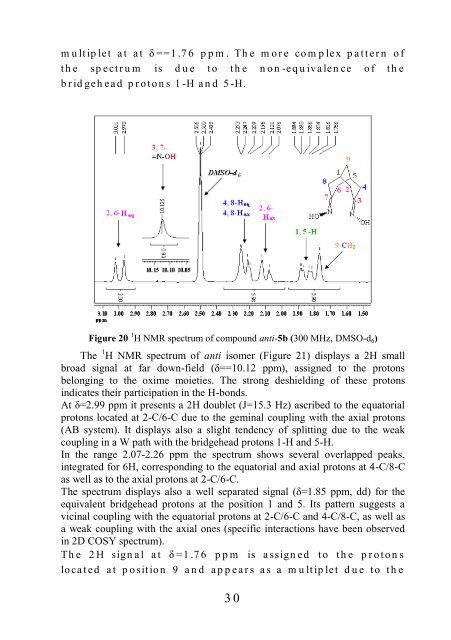Ph. D. THESIS 2009
Ph. D. THESIS 2009
Ph. D. THESIS 2009
You also want an ePaper? Increase the reach of your titles
YUMPU automatically turns print PDFs into web optimized ePapers that Google loves.
m u lt ip let a t a t δ ==1 .7 6 p p m . Th e m o r e co m p lex p a t t er n o f<br />
t h e sp ect r u m is d u e t o t h e n o n -eq u iv a len ce o f t h e<br />
b r id geh ea d p r o t o n s 1 -H a n d 5 -H.<br />
Figure 20 1 H NMR spectrum of compound anti-5b (300 MHz, DMSO-d 6)<br />
The 1 H NMR spectrum of anti isomer (Figure 21) displays a 2H small<br />
broad signal at far down-field (δ==10.12 ppm), assigned to the protons<br />
belonging to the oxime moieties. The strong deshielding of these protons<br />
indicates their participation in the H-bonds.<br />
At δ=2.99 ppm it presents a 2H doublet (J=15.3 Hz) ascribed to the equatorial<br />
protons located at 2-C/6-C due to the geminal coupling with the axial protons<br />
(AB system). It displays also a slight tendency of splitting due to the weak<br />
coupling in a W path with the bridgehead protons 1-H and 5-H.<br />
In the range 2.07-2.26 ppm the spectrum shows several overlapped peaks,<br />
integrated for 6H, corresponding to the equatorial and axial protons at 4-C/8-C<br />
as well as to the axial protons at 2-C/6-C.<br />
The spectrum displays also a well separated signal (δ=1.85 ppm, dd) for the<br />
equivalent bridgehead protons at the position 1 and 5. Its pattern suggests a<br />
vicinal coupling with the equatorial protons at 2-C/6-C and 4-C/8-C, as well as<br />
a weak coupling with the axial ones (specific interactions have been observed<br />
in 2D COSY spectrum).<br />
Th e 2 H sign a l a t δ =1 .7 6 p p m is a ssign ed t o t h e p r o t o n s<br />
lo ca t ed a t p o sit io n 9 a n d a p p e a r s a s a m u lt ip let d u e t o t h e<br />
30
















